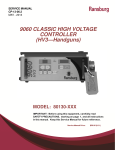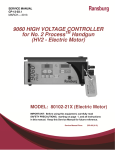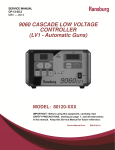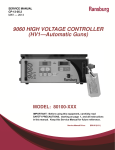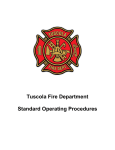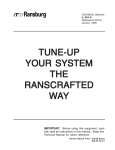Download CP-13-04.1 9060 Service Manual for No 2 Gun
Transcript
SERVICE MANUAL CP-13-04.1 MARCH — 2013 9060 HIGH VOLTAGE CONTROLLER for No. 2 ProcessTM Handgun (HV2 - Air Motor) MODEL: 80102-31X (Air Motor) ATEX APPROVED FOR USE WITH 80086-XX IMPORTANT: Before using this equipment, carefully read SAFETY PRECAUTIONS, starting on page 1, and all instructions in this manual. Keep this Service Manual for future reference. Service Manual Price: $50.00 (U.S.) CP-13-04.1 9060 for No. 2 Process Handgun - Contents CONTENTS SAFETY: PAGE 1-6 SAFETY PRECAUTIONS ......................................................................................................... 1 HAZARDS / SAFEGUARDS................................................................................................... 2-5 INTRODUCTION: 7-12 GENERAL DESCRIPTION........................................................................................................ 7 SAFETY FEATURES ................................................................................................................ 7 DISPLAYS ................................................................................................................................ 7 SPECIFICATIONS .................................................................................................................... 8 CONTROLLER FEATURES ...................................................................................................... 9 OPERATOR INTERFACE ....................................................................................................... 10 SWITCHES ............................................................................................................................. 10 LEDS ...................................................................................................................................... 10 BUTTONS .......................................................................................................................... 10-11 CONNECTION INTERFACE ................................................................................................... 11 CONNECTORS....................................................................................................................... 11 FUSES .................................................................................................................................... 11 SPARE FUSES ....................................................................................................................... 11 SIGNAL INTERFACE .............................................................................................................. 12 INSTALLATION: 13-16 GENERAL INFORMATION ..................................................................................................... 13 LOCATION OF THE 9060 ....................................................................................................... 13 AC INPUT CONNECTIONS ............................................................................................... 13-14 SAFETY GROUND ................................................................................................................. 14 INPUT VOLTAGE SELECTION .............................................................................................. 14 HIGH VOLTAGE CABLE......................................................................................................... 14 NO. 2 PROCESS HANDGUN TRIGGER SIGNAL .................................................................. 16 OPERATION: 17-22 START-UP .............................................................................................................................. 17 BASIC OPERATIONS ........................................................................................................ 17-18 LOCKOUTS ....................................................................................................................... 18-19 KV TEST JUMPER ................................................................................................................. 19 SETPOINT OPERATIONS ...................................................................................................... 20 FAULT DESCRIPTIONS .................................................................................................... 20-22 CP-13-04.1 9060 for No. 2 Process Handgun - Contents CONTENTS PAGE MAINTENANCE: 23-26 TROUBLESHOOTING GUIDE ................................................................................................ 23 FAULT TROUBLESHOOTING GUIDE ............................................................................... 23-25 PARTS IDENTIFICATION: 27-28 HIGH VOLTAGE CONTROLLER MODEL IDENTIFICATION ................................................. 27 PARTS LIST ........................................................................................................................... 28 ACCESSORIES: 29 ACCESSORIES LIST .............................................................................................................. 29 WARRANTY POLICIES: 30 LIMITED WARRANTY ............................................................................................................ 30 CP-13-04.1 CP-13-04.1 9060 for No. 2 Process Handgun - Safety SAFETY SAFETY PRECAUTIONS Before operating, maintaining or servicing any Ransburg electrostatic coating system, read and understand all of the technical and safety literature for your Ransburg products. This manual contains information that is important for you to know and understand. This information relates to USER SAFETY and PREVENTING EQUIPMENT PROBLEMS. To help you recognize this information, we use the following symbols. Please pay particular attention to these sections. A WARNING! states information to alert you to a situation that might cause serious injury if instructions are not followed. A CAUTION! states information that tells how to prevent damage to equipment or how to avoid a situation that might cause minor injury. A NOTE is information relevant to the procedure in progress. While this manual lists standard specifications and service procedures, some minor deviations may be found between this literature and your equipment. Differences in local codes and plant requirements, material delivery requirements, etc., make such variations inevitable. Compare this manual with your system installation drawings and appropriate Ransburg equipment manuals to reconcile such differences. ! WARNING The user MUST read and be familiar with the Safety Section in this manual and the Ransburg safety literature therein identified. This manual MUST be read and thor- oughly understood by ALL personnel who operate, clean or maintain this equipment! Special care should be taken to ensure that the WARNINGS and safety requirements for operating and servicing the equipment are followed. The user should be aware of and adhere to ALL local building and fire codes and ordinances as well as NFPA-33 SAFETY STANDARD, prior to installing, operating, and/or servicing this equipment. ! WARNING The hazards shown on the following page may occur during the normal use of this equipment. Please read the hazard chart beginning on page 2. Careful study and continued use of this manual will provide a better understanding of the equipment and process, resulting in more efficient operation, longer trouble-free service and faster, easier troubleshooting. If you do not have the manuals and safety literature for your Ransburg system, contact your local Ransburg representative or Ransburg. 1 CP-13-04.1 9060 for No. 2 Process Handgun - Safety AREA HAZARD Tells where hazards Tells what the hazard is. may occur. Spray Area Fire Hazard SAFEGUARDS Tells how to avoid the hazard. Fire extinguishing equipment must be present in the spray area and tested periodically. Improper or inadequate operation and maintenance proce- Spray areas must be kept clean to prevent the dures will cause a fire hazard. accumulation of combustible residues. Protection against inadvertent arcing that is capable of causing fire or explosion is lost if any safety interlocks are disabled during operation. Frequent Controller shutdown indicates a problem in the system requiring correction. Smoking must never be allowed in the spray area. The high voltage supplied to the atomizer must be turned off prior to cleaning, flushing or maintenance. When using solvents for cleaning: Those used for equipment flushing should have flash points equal to or higher than those of the coating material. Those solvents used for cleaning must have a flash point at minimum of 5°C (9°F) greater than ambient temperature. It is the end users responsibility to ensure this condition is met. Spray booth ventilation must be kept at the rates required by NFPA-33, OSHA, and local codes. In addition, ventilation must be maintained during cleaning operations using flammable or combustible solvents. Electrostatic arcing must be prevented. Test only in areas free of combustible material. Testing may require high voltage to be on, but only as instructed. Non-factory replacement parts or unauthorized equipment modifications may cause fire or injury. If used, the key switch bypass is intended for use only during setup operations. Production should never be done with safety interlocks disabled. Never use equipment intended for use in waterborne installations to spray solvent based materials. The paint process and equipment should be set up and operated in accordance with NFPA-33, NEC, and European Health and Safety Norms. CP-13-04.1 2 9060 for No. 2 Process Handgun - Safety AREA HAZARD SAFEGUARDS Tells where hazards may occur. Tells what the hazard is. Tells how to avoid the hazard. Spray Area Fire and/or explosion. Electrostatic arcing MUST be prevented. The 78789 control panel, LEPS5001 power supply and all other electrical equipment must be located outside Class I or II, Division 1 or 2 hazardous areas, in accordance with NFPA-33. Test only in areas free of flammable or combustible materials. The current overload sensitivity MUST be set as described in the OVERLOAD ADJUSTMENT Procedures section of this manual. Protection against inadvertent arcing that is capable of causing fire or explosion is lost if the current overload sensitivity is not properly set. Frequent power supply shutdown indicates a problem in the system which requires correction. Always turn the control panel off prior to flushing, cleaning, or working on spray system equipment. Ensure that the control panel is interlocked with the ventilation system and conveyor in accordance with NFPA-33, EN 50176. Have fire extinguishing equipment readily available and tested periodically. General Use and Maintenance Improper operation or mainte- Personnel must be given training in accordance nance may create a hazard. with the requirements of NFPA-33, EN 60079-0. Personnel must be properly Instructions and safety precautions must be trained in the use of this equip- read and understood prior to using this equipment. ment. Comply with appropriate local, state, and national codes governing ventilation, fire protection, operation maintenance, and housekeeping. Reference OSHA, NFPA-33, EN Norms and your insurance company requirements. 3 CP-13-04.1 9060 for No. 2 Process Handgun - Safety AREA HAZARD Tells where hazards Tells what the hazard is. Electrical Equipment High voltage equipment is utilized. Arcing in areas of flammable or combustible materials may occur. Personnel are exposed to high voltage during operation and maintenance. SAFEGUARDS Tells how to avoid the hazard. The power supply, optional remote control cabinet, and all other electrical equipment must be located outside Class I or II, Division 1 and 2 hazardous areas. Refer to NFPA-33 or EN 50176. Turn the power supply OFF before working on Protection against inadvertent arcthe equipment. ing that may cause a fire or explosion is lost if safety circuits are disTest only in areas free of flammable or comabled during operation. bustible material. Frequent power supply shut-down indicates a problem in the system Testing may require high voltage to be on, but only as instructed. which requires correction. An electrical arc can ignite coating Production should never be done with the materials and cause a fire or explo- safety circuits disabled. sion. Before turning the high voltage on, make sure no objects are within the sparking distance. Toxic Substances Certain material may be harmful if Follow the requirements of the Material Safeinhaled, or if there is contact with ty Data Sheet supplied by coating material the skin. manufacturer. Adequate exhaust must be provided to keep the air free of accumulations of toxic materials. Use a mask or respirator whenever there is a chance of inhaling sprayed materials. The mask must be compatible with the material being sprayed and its concentration. Equipment must be as prescribed by an industrial hygienist or safety expert, and be NIOSH approved. CP-13-04.1 4 9060 for No. 2 Process Handgun - Safety AREA HAZARD SAFEGUARDS Tells where hazards Tells what the hazard is. Tells how to avoid the hazard. may occur. Spray Area / High Voltage Equipment There is a high voltage device that can induce an electrical charge on ungrounded objects which is capable of igniting coating materials. Parts being sprayed must be supported on conveyors or hangers and be grounded. The resistance between the part and ground must not exceed 1 megaohm. (Reference NFPA-33 or EN 50176) All electrically conductive objects in the spray area, with the exception of those objects required by the Inadequate grounding will process to be at high voltage, must be grounded. cause a spark hazard. A spark can ignite many Any person working in the spray area must be coating materials and grounded. cause a fire or explosion. Unless specifically approved for use in hazardous locations, the power supply and other electrical control equipment must not be used in Class 1, Division 1 or 2 locations or Class 1, Zone 0 for European Applications. 5 CP-13-04.1 9060 for No. 2 Process Handgun - Safety NOTES CP-13-04.1 6 9060 for No. 2 Process Handgun - Introduction INTRODUCTION GENERAL DESCRIPTION The Ransburg No. 2 Handgun Process The No. 2 ProcessTM is an electrical atomization method for applying coatings to objects electrostatically. The No. 2 Process Handgun system applies a high voltage, negative, DC charge to the applicator bell, creating an electrostatic field between the bell and the target object. The target is electrically grounded through its support which may be stationary or moving; or through an electrical connection to a known true earth ground. A regulated pressure fluid system delivers coating material to the bell when the gun is triggered. There, the fluid travels across the face of the rotating bell and becomes charged. The fluid is electrically atomized at the edge of the bell forming a fine mist which, under the influence of the electrostatic field, is attracted to and deposited on the target object. The forces between the charged particles and the grounded target are sufficient to turn almost all overspray around and deposit it on the side and back surfaces of the target. Thus, a high percentage of the spray is deposited on the target and overspray is controlled. The 9060 Controller selection and adjustment of set point values is performed from the controller front panel. The triggering of the HV is initiated by the airflow switch built into the controller which senses airflow triggered by the No. 2 Process Handgun. SAFETY FEATURES The Ransburg 9060 High Voltage Controller provides maximized operational safety. The protections include detection of Ground Faults, Cable Faults, Feedback Signal Faults, Overvoltage, and Overcurrent. The microprocessor circuits provide a controlled output load curve, which limits the high voltage output to safe levels while monitoring control and feedback signals for unsafe conditions. Maximum operational safety is obtained when the correct applicator settings are used and when safe distances between the applicator and target are observed and followed. The maximum efficiency of the high voltage controller is based on load. DISPLAYS The front panel displays the high voltage set point as well as a reading of gun current output. The gun current is derived from feedback signals between the controller and the cascade. The 9060 High Voltage Controller The Ransburg 9060 High Voltage Controller (80102-31X) is used to provide high voltage for the No. 2 Process Handgun. It uses a combination of proven high voltage generation technology and microprocessor-based control. It uses a variable voltage output to drive a cascade that amplifies the voltage to a high kV level. It also uses current feedback information to maintain the desired set point. The processor circuitry provides the maximum in applicator transfer efficiency, while maintaining the maximum safety. 7 Figure 1: 9060 High Voltage Controller (HV2) CP-13-04.1 9060 for No. 2 Process Handgun - Introduction SPECIFICATIONS NOTE The 9060 High Voltage Controller is factory supplied with a latch (#E5-1-065091) that can be opened using the supplied key (#E3-2). The 9060 High Voltage Controller is available as follows: 9060 Part Used with No. 2 Gun No. Type Gun No. 80102-311 Air Motor, Domestic 80086-XX 80102-312 Air Motor, European 80086-XX 80102-313 Air Motor, China 80086-XX Environmental Operating Temperature: Storage and Shipping Temperature: 0°C to +40°C -40°C to +85°C (Allow power supply to go to room temperature before use) 95% Non-Condensing Humidity: Physical Height: 16.5 cm (6.5 inches) Width: 37.8 cm (14.9 inches) Depth: 30.7 cm (12.1 inches) 10.2 kg (22.5 lbs.) Weight: Electrical Input Voltage: 50 or 60 Hz Frequency: Current: 1 A max. RMS Wattage: 40 watts (max.) Output Voltage: Ground: CP-13-04.1 100-240 VAC 20-90kV MAX DC, adjustable in 1kV increments Use known good earth ground 8 9060 for No. 2 Process Handgun - Introduction Figure 2: 9060 High Voltage Controller Features 9060 CONTROLLER FEATURES 9 No. Description No. Description 1 kV Display 9 kV Setpoint/Adjust Buttons 2 High Voltage On Indicator 10 High Voltage Cable Connector 3 Reset Button 11 Fuses 4 µA Display 12 Ground Lug 5 Fault Indicator 13 AC Inlet Receptacle 6 On-Off Switch 14 Air Flow Switch Hose Connections 7 Local/Remote Mode Indicator 8 “One Touch” kV Setpoint Buttons CP-13-04.1 9060 for No. 2 Process Handgun - Introduction OPERATOR INTERFACE The 9060 Controller shown in Figure 3, has a simple operator interface consisting of 7 LEDs (Light Emitting Diodes), one (1) power switch, seven (7) buttons, one (1) current LED bargraph, and two (2) screens containing sevensegment displays. LOCAL Mode LED Indicator The LOCAL mode LED indicator is a left pointing triangle and is located on the left side the HV control button on the center of the operator interface. This LED is lit when the Controller is used with the No. 2 Process Handgun. Remote Mode LED Indicator The remove mode LED indicator should NOT be lit for No. 2 Process Handgun units. Active Preset LED Indicators (3) Figure 3: 9060 Operator Interface SWITCHES Power Switch The 9060 Controller contains a single rocker switch for power On/Off selection. When the unit is powered on, the screens should be lit and display the gun display type information and the software version number for a short period of time. LEDs High Voltage On Indicator The red High Voltage On Indicator is lit when a trigger signal has been received by the unit and the high voltage output from the cascade has been enabled. Fault Indicator The red Fault Indicator is lit when a fault occurs as determined by the microprocessor. When a fault occurs the light will turn on and the identification code for the fault will be displayed, blinking, on the µA meter display. For more information on the faults and fault ID codes, please refer the Fault Descriptions section in the Operations portion of this manual. CP-13-04.1 The active preset LED indicators are located directly above each of the Preset Buttons. When a preset button is pushed to select the desired preset, in READY mode, the preset LED indicator directly above the button pressed will light up. Only one (1) preset light should be lit at any one time. BUTTONS The seven buttons on the operator interface are used to select the KV presets, reset overloads and faults, access other modes and to navigate as well as modify information that is displayed on the two seven-segment display screens (µA and kV). Preset 1 Button The Preset 1 Button (on the left below the kV display) is used by itself to select “Voltage Preset 1”. If pressed with the reset button, at the same time, the screen will display the resettable High Voltage ON operating hours for 3 seconds on the display screens. Preset 2 Button The Preset 2 Button (in the center below the kV display) is used by itself to select “Voltage Preset 2”. If pressed with the reset button, at the same time, the screen will display the nonresettable High Voltage ON operating hours for 3 seconds on the display screens. Preset 3 Button The Preset 3 Button (on the right below the kV display) is used to select “Voltage Preset 3”. 10 9060 for No. 2 Process Handgun - Introduction Left (-)/Right (+) Buttons The left(-)/right(+) buttons are used to modify, decrease and increase respectively, the currently selected preset value. If the button is pressed and released, the preset value is changed by 1 kV at a time. If the button is held for over a 1/2 second, the value will begin changing by 5 kV increments. Reset Button The reset button is used to clear fault or overload conditions. This will NOT prevent any other active fault conditions from triggering a new fault. HV Control Button This button, shown in the center of Figure 3, is not functional for handgun units. Figure 4: 9060 Connection Interface voltage cable ground. Air Flow Switch Connection The air flow switch connection is installed to provide a pneumatic trigger signal for the No. 2 Process Handgun indicating that the trigger has been actuated. This signal is used to turn on the High Voltage output. AC Inlet Receptacle CONNECTION INTERFACE The 9060 Controller connection interface shown in Figure 4, provides all of the required connections for setting up a No. 2 Process Handgun painting system. This connection interface consists of one (1) high voltage cable connector, one (1) ground lug connection, one (1) air flow switch connection, two (2) fuses, and one (1) AC inlet receptacle. The AC inlet receptacle is a standard IEC C14 Appliance Inlet connector with a maximum rating of 250 VAC. It can handle both 110VAC and 240 VAC inputs at 50 or 60 Hz. The unit is shipped with the appropriate rated AC cord for the particular installation. FUSES Fuses CONNECTORS High Voltage Cable Connector The high voltage cable connector is the largest connector and is located on the far right of the connection interface. This connector is designed for use with the superflex high voltage cable 20988 that connects with the No. 2 Process Handgun. Ground Lug Connection The ground lug connection is located directly below the fuses and has a ground logo sticker directly below it. This lug is provided as an external ground connection point used to ground the 9060 to an earth ground via a ground cable. This ground lug connection can also be used as the ground point for the high 11 There are two (2) time delay fuses (250V, 1A, 5mm x 20mm) installed in fuse holders on the connection interface. They are located directly above the ground lug connection. They are present to provide a measure of safety against power surges through the AC input. The top fuse holder is connected in series between the HOT line (L) input connection and the Interlock AC line connection terminal 1TB-L2. The bottom fuse holder is connected in series between the neutral AC input connection and the neutral input connection of the AC line power filter. Spare Fuses The Controller also comes with two (2) spare fuses (250V, 1A, 5mm x 20mm) mounted in holders, inside the lid of the Controller. CP-13-04.1 9060 for No. 2 Process Handgun - Introduction SIGNAL INTERFACE The 9060 Controller, when configured for use with the No. 2 Process Handgun, requires only one signal input for operation, the trigger signal. Trigger Signal The trigger signal input (J3-5) for a No. 2 Process Handgun comes preconfigured as a sinking input wired directly to the air flow switch. Please refer to “Installation” section of this service manual for more information. CP-13-04.1 12 9060 for No. 2 Process Handgun - Installation INSTALLATION GENERAL INFORMATION LOCATION OF THE 9060 The following section contains general information on the installation of 9060 High Voltage Controller. Install the Controller in an area outside the hazardous location in accordance with federal, state, and local codes. The area should protect the Controller from the possibility of environmental intrusion (such as dust or moisture), have ambient temperatures that do not exceed 40°C, and be as close to the applicator as possible to minimize the length of the high voltage cable. ! WARNING The 9060 Controller MUST be located outside of the hazardous area. The User MUST read and be familiar with the “Safety” section of this manual. This manual MUST be read and thor- oughly understood by ALL personnel who operate, clean, or maintain this equipment! Special care should be taken to ensure that the warnings and requirements of operating and servicing safely are followed. The user should be aware of and adhere to ALL local building and fire codes and ordinances as well as NFPA-33, OSHA, and all related country safety codes prior to installing, operating, and/or servicing this equipment. Only approved applicators should be used with the 9060 High Voltage Controller. NOTE As each installation is unique, this information is intended to provide general installation information for the 9060 Controller. Consult your authorized Ransburg distributor for specific directions pertaining to the installation of your equipment. ! CAUTION DO NOT locate the Controller near or adjacent to heat producing equipment such as ovens, high wattage lamps, etc. AC INPUT CONNECTIONS For non-conduit installations, plug the detachable AC line cord into the receptacle on the side of the 9060 Controller. Plug the other end of the line cord into a properly grounded 120 volt AC outlet. For those installations where it is required to run the AC input wiring in conduit, perform the following: 1. Ensure the AC line cord is unplugged and remove the AC inlet receptacle wiring from TB1-N, TB1-L1 and TB1-EARTH GROUND (See Figures 5 and 7). 2. Remove the mounting hardware from the AC inlet receptacle and remove it from the side of Controller. 3. Install the Conduit Adapter Plate (supplied) in the hole where the AC inlet receptacle was removed (see Figure 6). 4. Install the AC input wiring (0.8mm2 (18AWG) minimum) through the Conduit 13 CP-13-04.1 9060 for No. 2 Process Handgun - Installation Adapter Plate using conduit and wire to TB1 as follows: ! CAUTION The ground wire assembly MUST be Hot/Line to TB1-L1 connected from the Controller ground stud to a true earth ground. Neutral/Common to TB1-N Ground to TB1-EARTH GROUND INPUT VOLTAGE SELECTION The 9060 Controller accepts universal input voltage between 100 and 240 VAC at 50 or 60 Hz. There is no need to change any switch settings when changing input from 110 to 240 VAC or from 240 to 110 VAC. NOTE Figure 5: Location of TB1 & TB2 in Controller All 9060 units (80102-31X) shipped from the factory for either 110 VAC input or 240 VAC input will have a 72771-06, 1 Amp front panel fuses installed. HIGH VOLTAGE CABLE Figure 6: Installation of Conduit Adapter Plate SAFETY GROUND Crimp the appropriate connector onto the ground wire assembly and install from the Controller ground stud, located on the side panel, to a true earth ground. Position the No. 2 Process Handgun in the spray area and route the high voltage cable to the Controller. The cable should be routed so that it is not damaged by foot and vehicle traffic and also so that is not close to areas of high temperature (129°F+). The operator should have free movement of the applicator and all bend radii of the cable should not be less than 6 -inches (15 cm). Connect the high voltage cable to the Controller and tighten the retaining nut and set screw. If during the routing of the high voltage cable it is required to remove it from the No. 2 Handgun, care should be taken when reinstalling so that the high voltage cable is completely engaged. ! WARNING The Controller MUST be OFF when the No. 2 Handgun is removed or reinstalled. CP-13-04.1 14 9060 for No. 2 Process Handgun - Installation Figure 7: Controller Schematic 15 CP-13-04.1 9060 for No. 2 Process Handgun - Installation NO. 2 PROCESS HANDGUN TRIGGER SIGNAL The No. 2 Process Handgun uses a flow switch (13742-02) to provide the trigger signal. The listed flow switch is mounted inside the 9060 Controller chassis via the Air Flow Switch Connector on the side panel. When the No. 2 Process Handgun trigger is pressed and flow starts, the flow switch is activated and triggers the high voltage. Ground Screw Figure 8: Ground Screw on Base Plate For reference, when replacing a flow switch, perform the following: 1. Turn the 9060 Controller off, disconnect it from its AC source, and remove the fuses. ! Pin 1 WARNING ALWAYS double check that the Con- troller is unplugged from its AC outlet before working with any internal wiring. Figure 9: PC Mainboard Jumper J5 Location 2. Open the controller cabinet door. 3. If the flow switch is being used, connect the ground (green) lead from the flow switch to the ground screw on the base plate shown in Figure 8. The trigger signal (blue) lead should be connected to the trigger signal input on the JB-5 plug header that is connected to the PC board. 4. Verify that J5, shown in Figure 9, has the shunt covering pins 1 and 2. 5. Secure the cabinet door, replace the fuses, and reconnect the AC source. CP-13-04.1 16 9060 for No. 2 Process Handgun - Operation OPERATION START-UP ! After all installation procedures are completed, operation of the applicator may begin. When the ON-OFF switch is turned on, the kV display will show the applicator type the 9060 Controller is configured for and the µA (microamp) display will show the current software revision level as shown in Figure 10. These items are displayed for approximately 10 seconds. WARNING DO NOT adjust the gun configuration jumpers. If they are incorrect, contact your Ransburg representative. USE ONLY the gun type configuration for the No. 2 Process Handgun. Using the wrong configuration may allow for operation outside the recommended parameters and values for the applicator and can result in damage or un-safe operation. After the initial start-up delay, the unit will be configured for the applicator based on the gun type jumper settings and is ready for standard operation. BASIC OPERATIONS Figure 10: Controller Start-Up Display The controller comes preconfigured for the No. 2 Process Handgun (Air Motor) from the factory. The following table lists the display value and jumper setting for the unit. This table is a reference to verify that the gun configuration jumpers are in their correct positions if unexpected behavior is observed. START-UP DISPLAY 17 Type Unit (Gun) Jumpers 90 No. 2 Handgun (Air Motor) 10, 11 The basic operations are general operations that are available. Triggering High voltage is actuated by the presence of an active trigger signal. This is normally accomplished by pulling the trigger of the No. 2 Process Handgun to start the flow of air through the applicator. The flow of air activates the air flow switch which sends a trigger signal to the 9060 unit. The kV setpoint is displayed on the kV display, the actual current draw on the µA display, and the high voltage light illuminates. Under the µA display is a bar graph meter that illuminates according to the actual current draw shown in Figure 11.The green and yellow regions of the bar graphs meter indicate output current is in the optimum range for maximum transfer efficiency. The red region of the bar graph indicates high output current causing decreased transfer efficiency. If high output, check maintenance of applicator and external equipment of the power supply. CP-13-04.1 9060 for No. 2 Process Handgun - Operation board (see Figure 13). These lockouts may be used individually or in combination as required. If the jumpers are disconnected, the original functions are re-enabled. After changing any jumpers, the AC power must cycled for the new setting to take affect. NOTE Some lockouts are sealed using sealant Figure 11: µA Bar Graph Meter Display to prevent them from being modified for safety reasons. These lockouts should ONLY be modified by Ransburg Authorized Representatives. Measuring “High Voltage On” Time The 9060 High Voltage Controller records the amount of time the high voltage is triggered on up to 99,999 hours. This value is display on the kV and µA displays of the unit. There are two registers that retain this information, one that may be reset, the other that is permanently retained in memory. The number of hours the unit’s high voltage has been on may be displayed by depressing at the same time the preset 1 and reset buttons (See Figure 12). The display will show hours of use for 3 seconds. This is the resettable register. To reset this register, press the reset button while the hours are displayed. To view the non-resettable register, press the preset 2 and reset buttons at the same time. This display will show the hours for 3 seconds. Figure 12: Display “High Voltage On” Time LOCKOUTS Figure 13: Lockout Jumper Location Front Panel Lockout This feature locks out any changes to the kV setting from the front panel of the Controller. 1. Set the kV to the desired value using the front panel buttons. This must be set prior to installing the jumper. 2. Turn AC power off and access the interior of the Controller. 3. Place the jumper across the two (2) pins at location 16 on the main PC board (See Figure 14). 4. Close the Controller and turn AC power back on. Pressing the front panel +, -, or setpoint buttons will now have no affect on the kV setting. There are lockouts that may be done at the PC CP-13-04.1 18 9060 for No. 2 Process Handgun - Operation KV TEST JUMPER Figure 14: Jumper Location - Front Panel Lockout Overload The overload circuit may be activated for applications that require overload indication or notification of high current draws of the applicator. The default overload value is set in the software to the maximum microamp rating minus 10 microamps. 1. Turn AC power off and access the interior of the Controller. 2. Place the jumper across the two (2) pins at location 17 on the main PC board (See Figure 15). 3. Close the Controller and turn AC power back on. An overload fault will now occur if the microamp display exceeds the overload value. To assist in testing and troubleshooting, a jumper (J8) has been added to the main PC board. By covering (shorting) both terminals of this jumper, the high voltage of the spray applicator can be activated. Thus, for testing and troubleshooting, high voltage output can be obtained without the need to trigger air through the spray applicator. After testing, the jumper must be repositioned so that it covers only one terminal (open) or the high voltage will stay on all the time. See Figure 16 for the location of KV test jumper J8. ! WARNING If jumper J8 is left covering (shorting) both terminals, high voltage will be on whenever the AC power is turned on. NOTE Use Ransburg Calibrated Equipment ONLY for testing and troubleshooting. Refer to the “Accessories” section of this manual for part numbers for testing equipment. Figure 16: Lockout Jumper Location Figure 15: Jumper Location - Overload Activation 19 CP-13-04.1 9060 for No. 2 Process Handgun - Operation SETPOINT OPERATIONS Adjusting Presets Voltage Setpoints The voltage on the 9060 High Voltage Controller is adjustable between 20 kV and full kV DC. There are 3 voltage setpoints (presets); 1, 2, and 3. Each of these setpoints can be individually adjusted between 20 kV and full kV DC. The three (3) factory preset voltages are listed in the following table: To adjust one of the preset setpoints, ensure the No. 2 Handgun is off in LOCAL mode and select the desired setpoint by pressing the corresponding setpoint button. The setpoint can then be adjusted between 20 kV and full kV using the + and - buttons on the front panel of the 9060 Controller shown in Figure 17. Single pushes of the + or - buttons will increment or decrement the currently selected preset in units of 1. When the + or - buttons are held in for longer than a 1/2 second, the kV display will begin incrementing or decrementing in units of five (5). Factory Presets Preset Value 1 Full kV minus 20 kV 2 Full kV minus 10 kV 3 Full kV NOTE The full kV DC value is determined by the gun type configuration for the particular applicator that is being used, NOT the full KV value of the cascade. Setting the Setpoint When the No. 2 Handgun is off, the present setpoint can be changed by pressing the 1, 2, or 3 buttons on the front panel shown in Figure 17. The setpoint that is currently selected will have the LED light in the upper right corner of the button lit. Resetting Faults During operation, various faults can occur based upon the operating conditions or if any problems with the 9060 unit arise. If a fault occurs, to reset a fault, turn off the No. 2 Handgun and press the Reset Button . This will clear the fault status and put the unit back into operation unless a fault condition is still present. Please refer to the “Fault Description” portion of the Operation Section of this Service manual for more information on a specific fault and how to correct it. FAULT DESCRIPTIONS For in depth troubleshooting information on the 9060, please refer to the “Fault Troubleshooting” portion of the Maintenance Section of this service manual. If a fault occurs, the Fault Indicator on the front of the Controller will light and a fault code will be displayed on the microamp display. Faults can be reset by pressing the Reset button on the front of the Controller or by using the remote I/O reset signal. NOTE Any fault code not listed that appear on the screen are a likely indication of a PC board failure due to possible arc damage. Figure 17: kV Adjust/Setpoint Buttons CP-13-04.1 20 9060 for No. 2 Process Handgun - Operation Cable Fault (CF) This fault will occur if high voltage is active and the microprocessor detects that no current is being supplied to the applicator. This indicates a connection problem from the control unit to the cascade or handgun barrel assembly. Typical causes include a faulty low voltage cable, stuck pins on the plug assembly, or contaminated contacts on the applicator. This may also indicate a faulty barrel assembly for a handgun. This could also indicate a connection problem between the pc board and the high voltage section. Check the wiring harness for loose pins, or replace the high voltage section. For additional information, refer to the Fault Troubleshooting Section. Figure 19: Ground Fault Display Overload Fault (OL) This fault will occur if the overload feature is active (see ‘Overload Activation” previously in the “Operation” section) and the output current exceeds the overload current value. This can be caused by excessive overspray on the applicator or paint formulation that is too conductive. Clean the applicator, check the paint formulation, or move overload jumper (JP17) to the open position. Figure 18: Cable Fault Display Ground Fault (GF) If this fault occurs, the fault indicator on the control unit will illuminate, a GF indication will show in the uA display. This fault will occur if the microprocessor detects a loss of ground at the high voltage section. If this fault occurs, reset the fault. This fault can be caused by a broken ground path between the applicator and the control unit and may indicate a faulty cable or plug assembly. It can also be caused by a broken ground path between the high voltage section and the pc board. Check the wiring to the high voltage section. For more information, refer to Fault Troubleshooting Section. 21 Figure 20: Overload Fault Display Current Limit Fault (CL) This fault occurs if the output current exceeds the maximum current by 20µA. This fault can be caused by excessive overspray on the applicator or a paint formulation that is too conductive. It may also be caused by a bad pc board. Clean the applicator, check the paint formulation, or replace the pc board. See Fault Troubleshooting Section for more information. CP-13-04.1 9060 for No. 2 Process Handgun - Operation Figure 21: Current Limit Fault Display Voltage Cable Fault (UC) This fault will occur if the microprocessor detects a loss of the voltage feedback signal. This can be caused by a failed high voltage cable, a failed high voltage section, or a failed pc board. Replace the high voltage cable and re-test. If still faulty, replace the high voltage section or pc board and re-test. Figure 23: Over Voltage Fault Display Feedback Fault (FF) This fault will occur if the microprocessor detects a loss of the current feedback signal. If this occurs, reset the fault. If this fault occurs repeatedly, refer to the Fault Troubleshooting Section to determine if the problem is with the high voltage section or the main pc board. Figure 22: Voltage Cable Fault Display Figure 24: Current Limit Fault Display Over Voltage Fault (OU) This fault will occur if the microprocessor detects the unit is trying to output voltage above the required for the specific applicator type. If this occurs, reset the Controller. If this fault continues to occur, replace the main PC board. CP-13-04.1 22 9060 for No. 2 Process Handgun - Maintenance MAINTENANCE TROUBLESHOOTING GUIDE General Problem Possible Cause Solution Blank Display 1. No power 1. Check the power connections and verify they are fully connected and power is available. Power cycle the unit off and back on. 2. Blown fuse 2. Check Fuses and replace if blown using the replacement fuses inside the lid of the unit. FAULT TROUBLESHOOTING GUIDE ! WARNING Before troubleshooting gun and control unit problems, flush the gun with solvent and purge with air. Some of the tests will require high voltage to be applied to the gun, so the gun must be empty of paint and solvent. Fault Description Solution Cable Fault (CF) The Cable Fault indicates the con- 1. Check for loose wiring between the pc trol unit does not detect a high board connector and the high voltage secvoltage section on the end of the tion by pulling on each wire. Repair if neccable. The fault typically occurs at essary. Insure both connectors are secure a high voltage trigger. and re-test for CF fault. 2. Replace high voltage section or send unit in for repair. 3. Send unit in for repair. 23 CP-13-04.1 9060 for No. 2 Process Handgun - Maintenance Fault Description Solution Ground Fault (GF) The Ground Fault is typically caused by a ground connection problem, and can create a safety hazard. It can occur without high voltage and will not reset. 1. Check for loose wiring between the pc board connector and the high voltage section by pulling on each wire. Repair if necessary. Insure both connectors are secure and re-test for GF fault. 2. Adjust the setpoint to 20kV and turn on the high voltage. A GF fault indicates a faulty pc board - replace. 3. Replace high voltage section or send unit in for repair. 4. Send unit in for repair. Over-Voltage Fault The Over Voltage Fault indicates the output voltage exceeds the (OU) design specifications. It typically occurs during a high voltage trigger. Over-Load Fault (OL) 1. Check connections using two finger pull test to ensure they are connected. 2. Replace the pc board. 3. Send unit in form repair. The Over Load Fault indicates the 1. This may indicate the paint conductivity is current output has exceeded the too high (resistance too low) or the outside overload threshold. This fault is of the applicator is contaminated with paint. only active if jumper 17 is shorted. The overload threshold is normally set at 10 µA below the maximum output of the applicator. Current Limit Fault The Current Limit Fault indicates the current output of the gun has (CL) 1. Clean outside of the applicator. exceeded the maximum allowable 2. Replace barrel or applicator. output current. It typically occurs 3. Send applicator in for repair. with the high voltage on. Feedback Fault (FF) The Feedback Fault indicates there is no current feedback or it is incorrect. It typically occurs with the high voltage on. 1. Securely attach a ground wire to the applicator electrode. 2. Set the high voltage to maximum and place a jumper across the flow switch. 3. The current reading on the control unit should rise up to the maximum current output. If it does not, send the applicator in for repair. CP-13-04.1 24 9060 for No. 2 Process Handgun - Maintenance Fault Description Solution Voltage Cable Fault (UC) The Voltage Feedback Fault indicates the cascade drive signal is not present. It typically occurs when high voltage is triggered. 1. Turn off the voltage controller and remove the high voltage cable from the voltage controller. 2. Turn on the power and place a jumper across the flow switch. If the fault occurs, send the voltage controller in for repair. If no fault occurs, continue. 3. Either the high voltage cable or if using a hand gun, the gun resistor tube has failed.. If available, replace the high voltage cable, or continue to test the resistor tube. 4. To test the resistor tube, remove the resistor tube from the gun and inspect for signs of burning or arcing. Cracks or black marks indicate failure of the resistor tube, indicating the resistor tube must be replaced. Measure the resistance using a trimeter connected to the black end of the tube and screwdriver in the other end. The measurement must be 150 to 170 Mega ohms. Replace resistor tube if the reading is not correct. 5. Replace high voltage cable or send applicator unit in for repair. 25 CP-13-04.1 9060 for No. 2 Process Handgun - Maintenance NOTES CP-13-04.1 26 9060 for No. 2 Process Handgun - Parts Identification PARTS IDENTIFICATION 9060 HIGH VOLTAGE CONTROLLER MODEL IDENTIFICATION * When ordering, use 80102-A1B as indicated by Table A and B. Three digits must follow the basic part number, for example: 80102 - A 1 B Basic Part Number Plug Selection (TABLE B) Model Selection (TABLE A) * Model number and serial number of the voltage controller is located on the left outside face of the main enclosure. Table A - Model Selection Dash No. Description No. 2 Process Gun - Air Motor 3 P/N 80086-XX Table B - Plug Selection Dash No. Description 27 1 Domestic 2 European 3 China CP-13-04.1 9060 for No. 2 Process Handgun - Parts 9060 High Voltage Controller - Parts List Part # Description 13742-02 Air Flow Switch (1.0 - 2.0 SCFM) 72771-06 Fuse (250V, 1A, 5mm x 20mm) 79390-03 9060 High Voltage Controller PC Mainboard 20988-XX Cable Assembly, Superflex, #2 Air Motor (XX denotes cable length) 79350-01 9060 High Voltage Cascade 76434-01 Switch, Rocker (On-Off Switch) 79428-00 Power Supply, 24V (24VDC Power Supply 1PS) Figure 25: Part Identifications CP-13-04.1 28 9060 for No. 2 Process Handgun - Accessories ACCESSORIES 9060 High Voltage Controller - Accessories List 29 Part # Description 76652-01 HV Probe 76652-02 Meter w/Test Leads 76652-03 Paint Test Probe w/Meter 76652-04 Deluxe Kit (Include HV Probe, Meter w/Test Leads, and Paint Test Probe) CP-13-04.1 9060 for No. 2 Process Handgun - Warranty Policies WARRANTY POLICIES LIMITED WARRANTY Ransburg will replace or repair without charge any part and/or equipment that falls within the specified time (see below) because of faulty workmanship or material, provided that the equipment has been used and maintained in accordance with Ransburg's written safety and operating instructions, and has been used under normal operating conditions. Normal wear items are excluded. THE USE OF OTHER THAN RANSBURG APPROVED PARTS, VOID ALL WARRANTIES. SPARE PARTS: One hundred and eighty (180) days from date of purchase, except for rebuilt parts (any part number ending in "R") for which the warranty period is ninety (90) days. EQUIPMENT: When purchased as a complete unit, (i.e., guns, power supplies, control units, etc.), is one (1) year from date of purchase. RANSBURG'S ONLY OBLIGATION UNDER THIS WARRANTY IS TO REPLACE PARTS THAT HAVE FAILED BECAUSE OF FAULTY WORKMANSHIP OR MATERIALS. THERE ARE NO IMPLIED WARRANTIES NOR WARRANTIES OF EITHER MERCHANTABILITY OR FITNESS FOR A PARTICULAR PURPOSE. RANSBURG ASSUMES NO LIABILITY FOR INJURY, DAMAGE TO PROPERTY OR FOR CONSEQUENTIAL DAMAGES FOR LOSS OF GOODWILL OR PRODUCTION OR INCOME, WHICH RESULT FROM USE OR MISUSE OF THE EQUIPMENT BY PURCHASER OR OTHERS. EXCLUSIONS: If, in Ransburg's opinion the warranty item in question, or other items damaged by this part was improperly installed, operated or maintained, Ransburg will assume no responsibility for repair or replacement of the item or items. The purchaser, therefore will assume all responsibility for any cost of repair or replacement and service related costs if applicable. WRAPPING THE APPLICATOR, ASSOCIATED VALVES AND TUBING, AND SUPPORTING HARDWARE IN PLASTIC, SHRINK-WRAP, OR ANY OTHER NONAPPROVED COVERING, WILL VOID THIS WARRANTY. CP-13-04.1 30 9060 for No. 2 Process Handgun - Warranty Policies Manufacturing 1910 North Wayne Street Angola, Indiana 46703-9100 Telephone: 260-665-8800 Fax: 260-665-8516 Technical Service—Assistance 320 Philips Ave. Toledo, Ohio 43612-1493 Telephone (toll free): 800-233-3366 Fax: 419-470-2233 Technical Support Representative will direct you to the appropriate telephone number for ordering Spare Parts. © 2013 Ransburg. All rights reserved. Models and specifications subject to change without notice. 31 Form No. CP-13-04.1 Litho in U.S.A. 03/13 CP-13-04.1




































